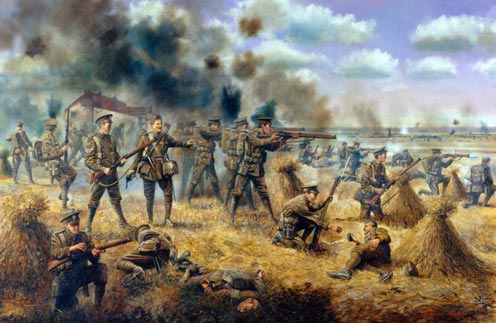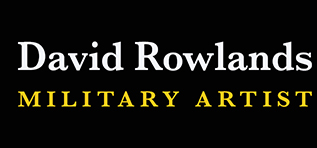« Click on Picture to
Return »
 |
|
1st Battalion The Cheshire Regiment at Audregnies
24th August 1914: At the close of the Battle of Mons, due to a confusion of orders, Lt Col D C Boger, the Commanding Officer of 1st Battalion The Cheshire Regiment, did not know that other British troops on his left and right had withdrawn, and his battalion was left exposed to the attack of two German Army Corps at a village called Audregnies. On a stretch of roadside there was one lone, small cottage, which became Battalion HQ. There was no time for trench digging. The Battalion's two machine guns were placed near the cottage, one on each side, and opened fire on the two German columns which were advancing across the fields in close order.
As German high explosive and shrapnel shells landed amongst them the soldiers kept up a superb rapid fire from their Lee-Enfields throughout that hot afternoon. They were causing havoc among the advancing German ranks, but ammunition began to run low. Pressed in front and outflanked by superior numbers, the rifle companies were ordered to withdraw, yard by yard, disputing every inch of the ground. The flank companies (two platoons of B Company on the left; and D Company on the right) retired about 1500 hours. Meanwhile, A and C Companies faced the advancing enemy. About 1600 hours, Lt Col Boger moved among his remaining companies to assess the situation, and about half an hour after this he ordered the remaining groups of men to retire. Captain Dugmore began ordering his men to retire ‘individually’ from the right. Captain Dyer drew his sword and ordered the men in his vicinity to advance toward the old mill to their left and enfilade the enemy. He did not know that the battalion was surrounded. Capt Massey (2ic A Coy), Capt Jolliffe and Lt Matterson joined Capt Dyer, and together with about 30 men of A and B Companies, they charged forward in short rushes, intent on meeting the enemy with the bayonet. It was a last despairing effort to avert the complete annihilation of their comrades. All but Lt Matterson and 10 men were shot down.
The Cheshire Military Museum has tape recordings, made some years ago, of recollections by old soldiers who fought there. They recalled the gleaming sunshine, and the stooks of corn in the fields, which they used as cover. Shells were bursting around the unprepared positions, and the men were kneeling or lying behind any cover they could find. A group of 25 or 30 men were standing firing in a half circle round their officer, and some began to fix bayonets as the Germans closed in. The enemy moved forward in masses, shoulder to shoulder. The museum has modern photographs of the battlefield.
I have shown A Company, commanded by Captain Dyer, to the right of the lone farm building which served as the battalion HQ. The road was slightly sunken, so fields of fire could only be obtained from the open fields beyond the road. Two platoons of A Company advanced 150 yards from the road to form their firing line. An old photograph shows the ruined windmill about a third of a mile away in the middle distance. The German artillery was soaking the position with high explosive and shrapnel.
Their heroic stand decimated the Battalion, with 770 lost in one afternoon, but they saved the British Expeditionary Force from disaster.
The picture was commissioned by The 22nd (Cheshire) Regiment.
Medium: Oil on Canvas
Printed image size(s): B2 only (58 x 38 cm)
Owner: 1st Battalion (The Cheshires) The Mercian Regiment
Price(s): £75
|
|



